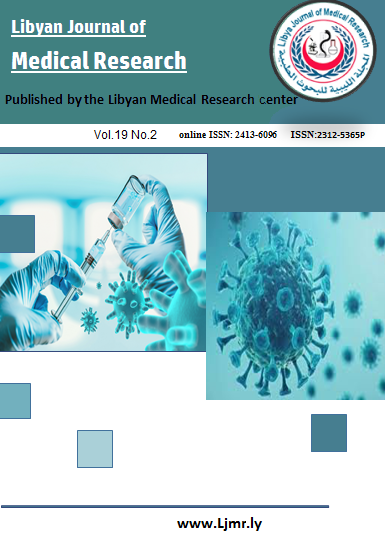Nephrogenic adenoma of the urinary bladder: A Histopathological case report
DOI:
https://doi.org/10.54361/LJMR.19.2.30Keywords:
Urinary bladder, benign lesions, pathology of urinary bladder, nephrogenic adenomaAbstract
We report the case of a 31-year-old man presenting with painless macroscopic hematuria, a rare symptom in young adults that often requires a thorough evaluation to exclude an underlying malignancy. Initial uroimaging and cystoscopic examination revealed a papillary lesion originating from the bladder neck and extending to the prostatic urethra, strongly suggesting a neoplastic process. The patient underwent transurethral resection of the bladder tumor (TURBT), and histopathological analysis of the resected tissue revealed architectural and cytological features characteristic of a nephrogenic adenoma, a rare benign metaplastic lesion of the urothelium. Microscopic examination revealed tubular and papillary structures lined with cuboidal to nail-shaped epithelial cells, embedded in an edematous stroma. No cytological atypia, mitotic activity, or signs of urothelial carcinoma or other malignant transformation were identified. Nephrogenic adenoma is often misdiagnosed as carcinoma due to its histological resemblance to malignant entities, including adenocarcinoma and nested variants of urothelial carcinoma. This case highlights the critical importance of accurate histopathological interpretation to avoid overtreatment, particularly in young patients, for whom the psychosocial and physical consequences of a cancer diagnosis can be profound. This report aims to raise awareness among clinicians about this rare entity, highlight the diagnostic challenges it poses, and emphasize the need for clinicopathological correlation to ensure appropriate patient management. The patient's postoperative course was uneventful, and no recurrence was observed during short-term follow-up.
Downloads
References
1. Alexiev, B. A., & LeVea, C. M. (2012). Nephrogenic adenoma of the urinary tract: a review. International journal of surgical pathology, 20(2), 121-129.
2. Venyo, A. K. G. (2015). Nephrogenic adenoma of the urinary bladder: a review of the literature. International scholarly research notices, 2015(1), 704982.
3. Gordetsky, J., Gennaro, K. H., Selph, J. P., & Rais-Bahrami, S. (2016). Nephrogenic adenoma: clinical features, management, and diagnostic pitfalls. Urology, 95, 29-33.
4. Chen, C. S., & Cheng, C. L. (2006). Nephrogenic adenoma of the urinary bladder: clinical experience and review of the literature. Journal of the Chinese Medical Association, 69(4), 166-168.
5. Santi, R., Angulo, J. C., Nesi, G., de Petris, G., Kuroda, N., Hes, O., & López, J. I. (2019). Common and uncommon features of nephrogenic adenoma revisited. Pathology-Research and Practice, 215(10), 152561.
6. Amin, W., & Parwani, A. V. (2010). Nephrogenic adenoma. Pathology-Research and Practice, 206(10), 659-662.
7. López, J. I., Schiavo-Lena, M., Corominas-Cishek, A., Yagüe, A., Bauleth, K., Guarch, R., ... & Tardanico, R. (2013). Nephrogenic adenoma of the urinary tract: clinical, histological, and immunohistochemical characteristics. Virchows Archiv, 463, 819-825.
8. Kryvenko, O. N., Wasco, M. J., & Williamson, S. R. (2023). Nephrogenic adenoma intermixed with urothelial carcinoma: a potential mimic of divergent glandular differentiation, variant morphology, or invasion. Archives of Pathology & Laboratory Medicine, 147(5), 552-558.
9. Friedman, N. B., & Kuhlenbeck, H. (1950). Adenomatoid tumors of the bladder reproducing renal structures (nephrogenic adenomas). The Journal of Urology, 64(5), 657-670.
10. Allan, E. (1975). Nephrogenic adenoma of the bladder. The Journal of Urology, 113(1), 35-41.
11. Quinones, W., Ziober, A., Yao, Y., & Bing, Z. (2013). Immunohistochemical markers for the differential diagnosis of nephrogenic adenomas. Annals of Diagnostic Pathology, 17(1), 41-44.
12. Fromont, G., Barcat, L., Gaudin, J., & Irani, J. (2009). Revisiting the immunophenotype of nephrogenic adenoma. The American journal of surgical pathology, 33(11), 1654-1658.
13. Garcia-Penit, J., Orsola, A., Parada, R., Algaba, F., & Garat, J. M. (1999). Synchronous nephrogenic adenoma in the bladder and neourethra (bladder mucosa) in a boy. BJU international, 84, 169-170.
14. Banyai-Falger, S., Maier, U., Susani, M., Wiener, H., Watschinger, B., Hörl, W. H., & Banyai, M. (1998). High incidence of nephrogenic adenoma of the bladder after renal transplantation. Transplantation, 65(4), 511-514.
Downloads
Published
Issue
Section
License
Copyright (c) 2025 Mohamed A. Elwafi , Rihab Abdlsalam Alweshahi , Khaled Abdulmola (Author)

This work is licensed under a Creative Commons Attribution-NonCommercial-NoDerivatives 4.0 International License.
Open Access Policy
Libyan journal of medical Research (LJMR).is an open journal, therefore there are no fees required for downloading any publication from the journal website by authors, readers, and institution.
The journal applies the license of CC BY (a Creative Commons Attribution 4.0 International license). This license allows authors to keep ownership f the copyright of their papers. But this license permits any user to download , print out, extract, reuse, archive, and distribute the article, so long as appropriate credit is given to the authors and the source of the work.
The license ensures that the article will be available as widely as possible and that the article can be included in any scientific archive.
Editorial Policy
The publication of an article in a peer reviewed journal is an essential model for Libyan journal of medical Research (LJMR). It is necessary to agree upon standards of expected ethical behavior for all parties involved in the act of publishing: the author, the journal editorial, the peer reviewer and the publisher.
Any manuscript or substantial parts of it, submitted to the journal must not be under consideration by any other journal. In general, the manuscript should not have already been published in any journal or other citable form, although it may have been deposited on a preprint server. Authors are required to ensure that no material submitted as part of a manuscript infringes existing copyrights, or the rights of a third party.
Authorship Policy
The manuscript authorship should be limited to those who have made a significant contribution and intellectual input to the research submitted to the journal, including design, performance, interpretation of the reported study, and writing the manuscript. All those who have made significant contributions should be listed as co-authors.
Others who have participated in certain substantive aspects of the manuscript but without intellectual input should only be recognized in the acknowledgements section of the manuscript. Also, one of the authors should be selected as the corresponding author to communicate with the journal and approve the final version of the manuscript for publication in the LJMR.
Peer-review Policy
- All the manuscripts submitted to LJMR will be subjected to the double-blinded peer-review process;
- The manuscript will be reviewed by two suitable experts in the respective subject area.
- Reports of all the reviewers will be considered while deciding on acceptance/revision or rejection of a manuscript.
- Editor-In-Chief will make the final decision, based on the reviewer’s comments.
- Editor-In-Chief can ask one or more advisory board members for their suggestions upon a manuscript, before making the final decision.
- Associate editor and review editors provide administrative support to maintain the integrity of the peer-review process.
- In case, authors challenge the editor’s negative decision with suitable arguments, the manuscript can be sent to one more reviewer and the final decision will be made based upon his recommendations.












